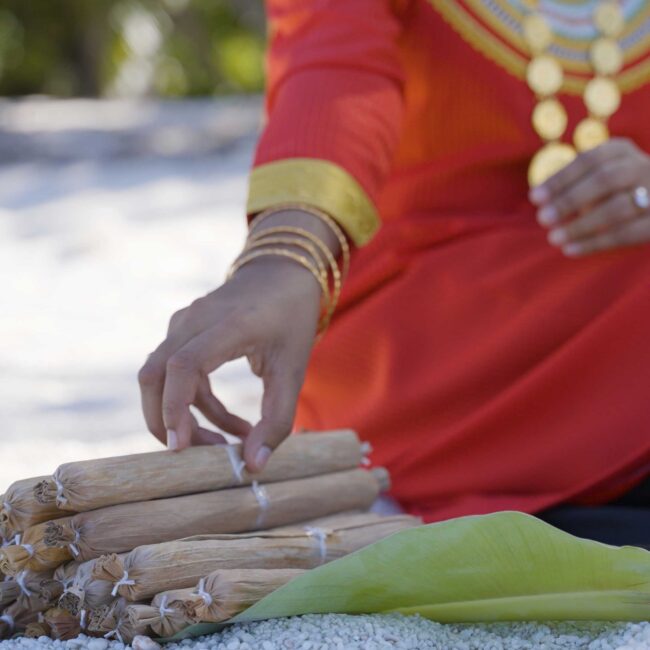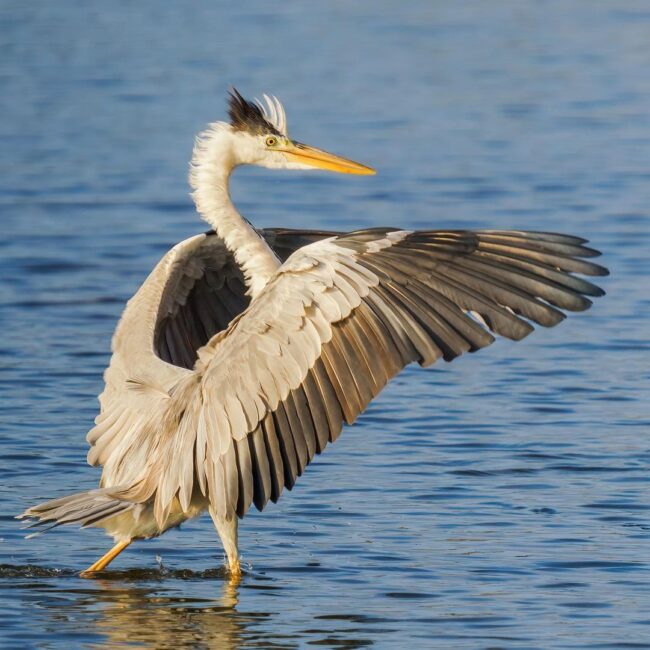Island Guides
Explore Fuvahmulah
Swim with 07 Species of Sharks in the Maldives
Only in Fuvahmulah Island, in the Sunny Side of Life
Fuvahmulah, located on the very edge of the Sunny Side of Life, is a single island atoll that makes up one-half of the Southern Heart of the Maldives, together with Addu. A lovely little volcanic island with a slew of mangroves, wetlands, freshwater lakes, marshes and taro fields, Fuvahmulah gives off a very different vibe from the rest of the Maldives. This UNESCO Biosphere Reserve is truly a destination to experience the local way of life in the archipelago with a distinct dialect, unique cuisine, and a series of historical monuments and sites that give insight into the life of the Maldives of yore.
1. Tiger Sharks AKA Sea Tigers
Fuvahmulah is one of the only sites in Southeast Asia where you are guaranteed to see Tiger Sharks on every dive! Tiger sharks, also known as Sea Tigers, are a species of sharks that can grow up to 5 metres in length and are a majestic sight for any diver. Fuvahmulah has an area fondly referred to as the ‘Tiger Zoo’, where you are guaranteed to safely see and dive with these macro predators. Credits: Xtreme Dive Fuvahmulah www.instagram.com/xtremedivefuvahmulah


2. Thresher Sharks AKA Sea Foxes
Thresher Sharks are easily identifiable by the exceptionally long upper lobe of their tail, which can be the same size as the rest of the shark, which may be why they earned the moniker Sea Fox. This shy shark can oftentimes be seen jumping straight up out of the water like a dolphin; a mesmerising, if slightly bewildering, sight. They can grow up to 6 metres long and weigh up to 340 kg. Fuvahmulah is one of the rare places where you can see Thresher sharks in their natural habitats, as they really are difficult to approach and very shy creatures. They are not as frequently sighted as Tiger Sharks, so make sure to tell your dive master if you want to see this shark during your dive, and they will make sure to take you to the secret spots. Credits: Pelagic Dive Fuvahmulah www.instagram.com/pelagicdivefuvahmulah
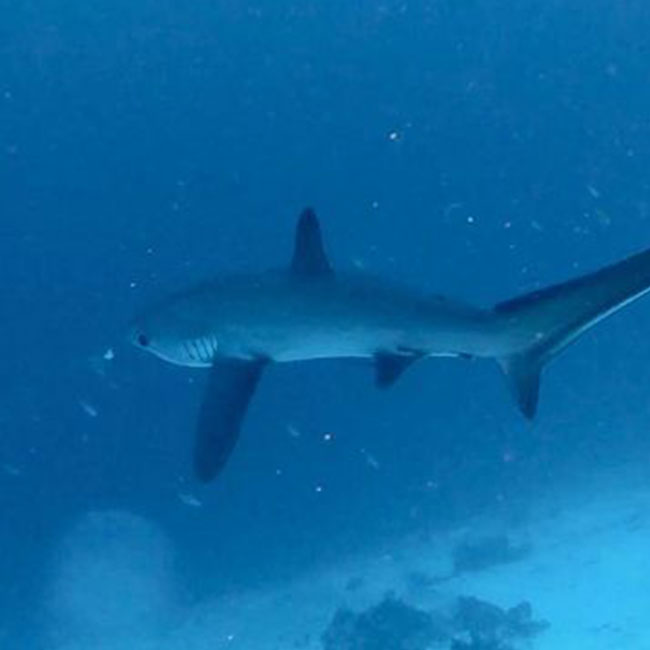

3. Hammerhead Sharks
Hammerhead Sharks are the most distinctive and unique sharks that you will see. Their name comes from the shape of their head- much like a hammer with wide-spaced eyes on either side of the head that gives it a cute and almost dopey look. Don’t be fooled by the cuteness though, as they are predators. They are also an extremely shy species of sharks that often hide from humans, and should only be viewed with the guidance and supervision of your dive master. These strangely-shaped sharks can be found in waters surrounding Fuvahmulah between November and April. Fuvahmulah mostly plays host to the smaller variant, Scalloped Hammerheads, with females growing up to only 3.3 metres. Credits: Pelagic Dive Fuvahmulah www.instagram.com/pelagicdivefuvahmulah
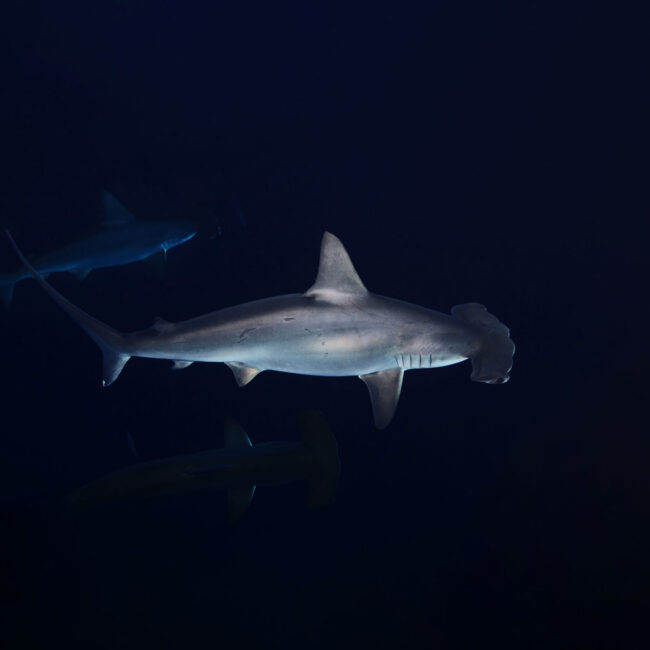

4. Whale Sharks AKA The Gentle Giants
A lot of people have the misconception that whale sharks are whales, but they are actually a species of sharks. Known as the gentle giants of the ocean, a whale shark is a slow-moving, filter-feeding carpet shark known to be the largest fish (non-mammalian) in the world. There are many spots in the Maldives that are frequented by these delightful creatures, and Fuvahmulah is one of those spots. Whale sharks are typically found in and around strategic sites located near Fuvahmulah from January to May. The whale sharks that frequent this location aren’t as large as the usual specimens, typically ranging between 6 and 9 metres. Whale sharks are extremely gentle, shy, and sweet creatures which should not be approached lest you stress them out. For a full guideline on how to safely dive with whale sharks, click here. Credits: Pelagic Dive Fuvahmulah www.instagram.com/pelagicdivefuvahmulah
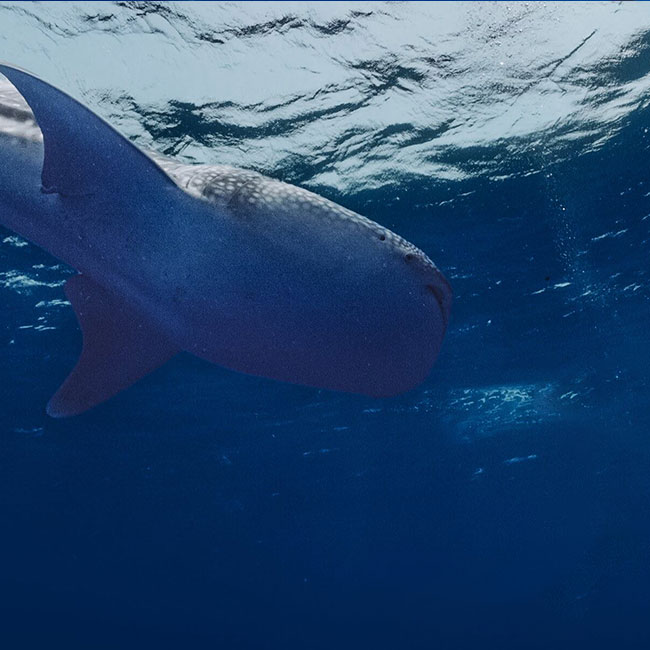

5. Silvertip Sharks
Silvertip Sharks are called Kattafulhi Miyaru in Dhivehi, and are a species of fairly common sharks in the warm waters of the Maldives. Their rounded snouts are a distinctive feature, as is the white colouring on the tips of all their fins, which is where the name comes from. Silvertip Sharks are fairly common in the waters in and around Fuvahmulah and can be seen year-long. As with almost all the other sharks on this list, they are apex predators and should not be approached, and only be viewed with caution and the guidance of your dive master. Credits: Pelagic Dive Fuvahmulah www.instagram.com/pelagicdivefuvahmulah
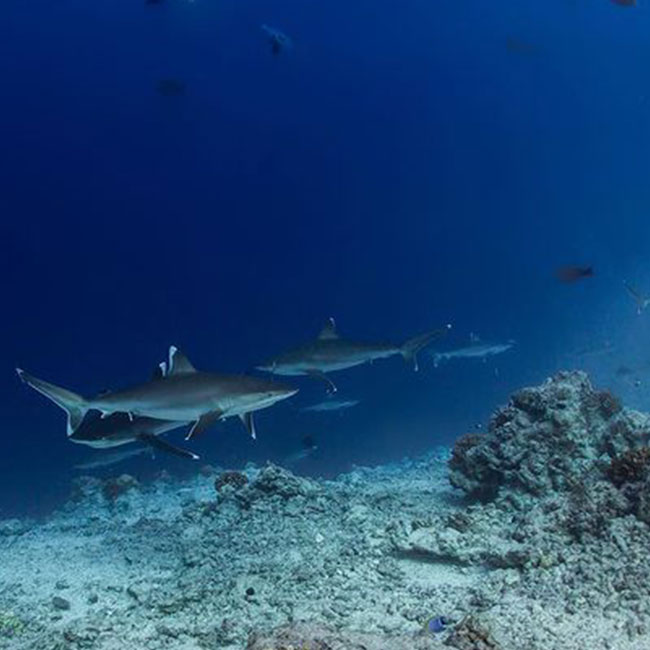

6. Whitetip Reef Sharks
What makes a Whitetip Reef Shark different from a Silvertip Shark? With a slim body that rarely grows larger than 2 metres, this shark has a more square snout than its silvertip cousins, and no white marks on the tips of its pectoral fins. The colouration is greyish to brownish on top and white on the underside with a pattern of scattered small, dark spots unique to each individual. A unique thing about these sharks is that they don’t have to constantly be moving for respiration, unlike their other requiem shark cousins. They can lay, completely motionless, on the bottom of the ocean floor and pump water over their gills for respiration. They often rest during the day in caves or other hidey-holes, solo or in groups, and sometimes stacked on top of each other almost like a puppy-pile. Whitetip Reef Sharks are also fairly common in the waters in and around Fuvahmulah and can be seen year-long. They should not be approached, and only be viewed with caution and the guidance of your dive master. Credits: Pelagic Dive Fuvahmulah www.instagram.com/pelagicdivefuvahmulah
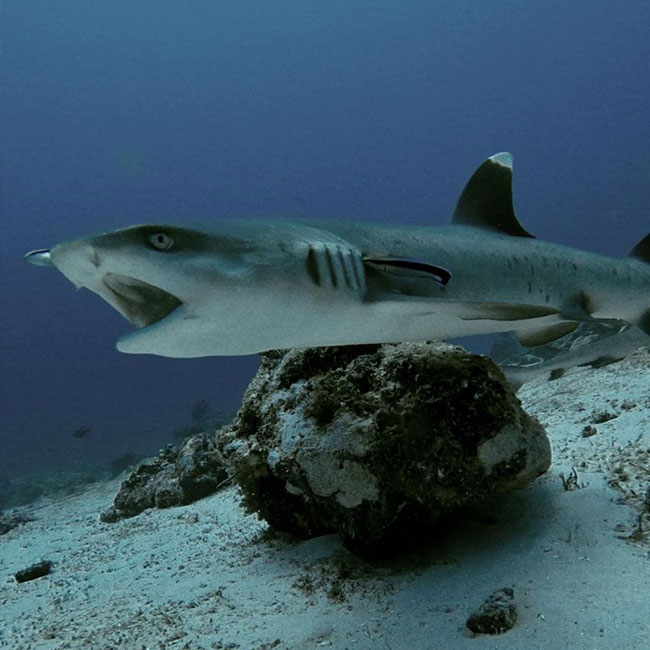

7. Grey Reef Sharks
Have you ever seen the eyes of a Grey Reef Shark? If you have, you already know what we are talking about, but if you haven’t, we certainly recommend a peek. Grey Reef Sharks are fairly common in the waters of the Maldives, called Vahboa Miyaru, which directly translates to ‘Roundhead shark’, named no doubt for its rounded, long, and blunt snout. Grey Reef Sharks are also famous for the aforementioned big, round, and bright eyes. Oftentimes people mistake these for their silvertip cousins, but you can easily tell them apart by the lack of white coloured tips on the fins of Grey Reef Sharks. These sharks are also seen year-round in the ecorich reefs surrounding Fuvahmulah, and can grow up to some 2 metres long. This is a very social species among themselves with strict social hierarchies in groups of more than 100. You should never approach this shark, under any circumstance, or try to dive around them without your dive master present. Credits: Pelagic Dive Fuvahmulah www.instagram.com/pelagicdivefuvahmulah
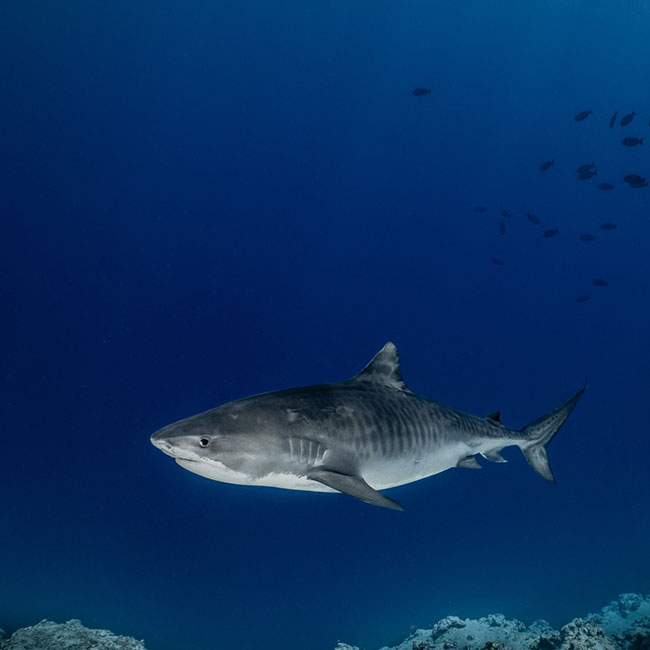

BONUS: Mantas and Mobulas, Mola Mola, Turtles, Tuna, Barracuda & many more!
Sharks are not the only thing that Fuvahmulah’s diving scene is famous for. As a matter of fact, due to the natural geographic formation of the volcanic island, Fuvahmulah plays host to a variety of pelagic fish and oceanic creatures. Oceanic Mantas frequent the cleaning station at the island regularly, and can most frequently be sighted between the months of March and May. Oceanic Mantas can grow to very large sizes and is a truly majestic sight to see them gliding gently in the waters. Mola Mola (and sometimes even whales!) like to visit this island, usually from January to March, although in smaller numbers than the rest of the creatures we have talked about. Green sea turtles can often be found lazing around in the reefs of the island- all turtle species found in the Maldives have protected status. Tuna, Barracuda and other fish hang around in large schools in Fuvahmulah year-round, and can be sighted during every dive. Credits: Pelagic Dive Fuvahmulah www.instagram.com/pelagicdivefuvahmulah


There is one other thing that Fuvahmulah is famous for worldwide though, and that is as a haven for divers. The biodiversity of the reefs surrounding Fuvahmulah is second to none in the Maldives, especially when it comes to sharks. A total of 7 species of sharks regularly frequent the waters in and around Fuvahmulah, and with a little bit of luck and plenty of preparation, you may be able to see all 7 in a single dive!
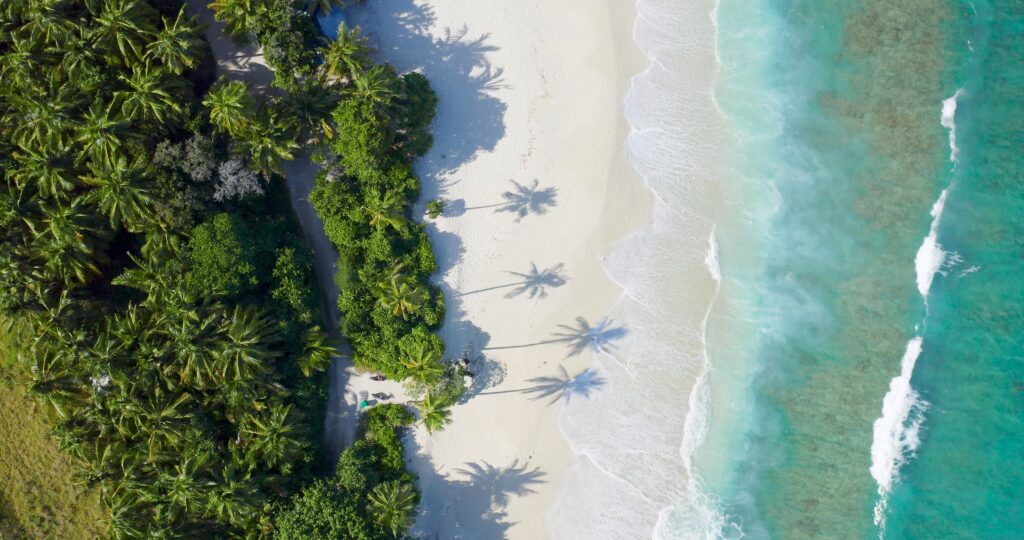
LOCAL ISLAND GUIDES
Swipe through our collection of island guides for your next Maldives holiday inspiration

